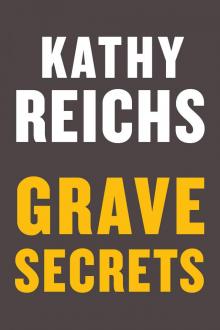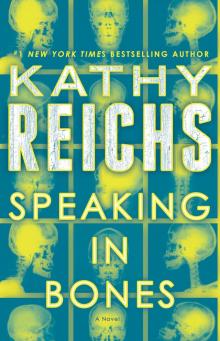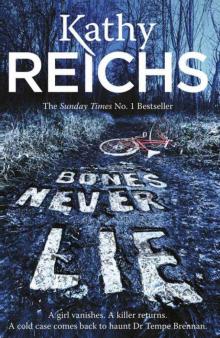- Home
- Kathy Reichs
Death Du Jour
Death Du Jour Read online
“Fans of TV’s CSI: Crime Scene Investigation should be in heaven” (People) stepping into the world of forensic anthropologist Dr. Temperance Brennan, star of Kathy Reichs’ electrifyingly authentic bestsellers.
Using her expertise to detect a murderous pattern is all in a day’s work.
In the bitter cold of a Montreal winter, Tempe Brennan is digging for a corpse buried more than a century ago. But it’s a chain of contemporary deaths and disappearances that has seized her attention—and she alone is ideally placed to make a chilling connection among the seemingly unrelated events. At the crime scene, at the morgue, and in the lab, Tempe probes a mystery that sweeps from a deadly Quebec fire to startling discoveries in the Carolinas, and culminates in Montreal with a terrifying showdown—a nerve-shattering test of her affinities for both science and survival.
“ATMOSPHERIC, SUSPENSEFULLY PACED. . . . A DELECTABLE TALE OF CORPUS DELICTI . . . BONE-CHILLING PRIME CRIME.”
—People
“BRENNAN IS A WINNER, AND SO IS REICHS.”
—Daily News (New York)
Includes an excerpt from Bones to Ashes—coming soon in hardcover from Scribner!
Register online at www.simonandschuster.com for more information on this and other great books.
www.fox.com/bones
TM & © Fox. All Rights Reserved.
ABOUT THE AUTHOR
KATHY REICHS, like her fictional creation Temperance Brennan, is a board-certified forensic anthropologist for the Laboratoire de Sciences Judiciaires et de Médecine Légale for the province of Quebec, a position she also held at the Office of the Chief Medical Examiner, State of North Carolina. She is Vice President of the American Academy of Forensic Sciences and serves on the National Police Services Advisory Council in Canada. A professor of anthropology at the University of North Carolina at Charlotte, Dr. Reichs received her Ph.D. at Northwestern University. She now divides her time between Charlotte and Montreal. Her debut novel, Déjà Dead, brought her fame when it became a New York Times bestseller, a #1 international bestseller, and winner of the 1997 Ellis Award for Best First Novel. Bones to Ashes, her tenth Temperance Brennan novel, is forthcoming in hardcover from Scribner.
Her website is www.kathyreichs.com.
KATHY REICHS’
DÉJÀ DEAD
THE SHATTERING NEW YORK TIMES AND USA TODAY BESTSELLER
#1 INTERNATIONAL BESTSELLER
WINNER OF THE CRIME WRITERS OF CANADA’S PRESTIGIOUS ARTHUR ELLIS AWARD FOR BEST FIRST NOVEL
“The showdown is scary enough to keep the lights on and the dog inside. Reichs is that good.”
—Bill Bell, New York Daily News
“Déjà Dead can lie side-by-side with the works of Patricia Cornwell. . . . Both do a fine job of telling a good, sometimes scary tale.”
—Elizabeth Cosin, The Washington Times
“Accomplished and chilling. . . . Reichs not only serves up a delicious plot, she also brings a new recipe to hardboiled cop talk.”
—J.D. Reed, People
“It’s mesmerizing to watch as Temperance slices, measures, and weighs. . . . We can rely on her clinical detachment and female concern.”
—Patricia Holt, San Francisco Chronicle
“A strong, authentic, and welcome new voice. . . . Tempe Brennan is both a smart crime solver and a vulnerable human being. . . . What she says and what she does ring very true.”
—John Douglas (former chief of the FBI Profiling Unit) and Mark Olshaker, New York Times bestselling authors of The Anatomy of Motive
“Reichs knows how to put all [her] exotic experience into a novel.”
—Margaret Cannon, The Globe and Mail (Toronto)
“A prodigious new talent in the crime game. . . . Reichs entertains readers even as she educates them in some of the finer points of forensics.”
—Publishers Weekly (starred review)
“As good as Cornwell at her best.”
—Lev Raphael, Detroit Free Press
“Reichs tells a good, grisly story.”
—Mary Cantwell, Vogue
“Welcome Kathy Reichs and her forensic investigator Tempe Brennan, a great combination! . . . I loved Déjà Dead.”
—Janet Evanovich, bestselling author of High Five
“Gruesomely authentic, dark and troubling, this one will have you on the edge of your seat until its gripping conclusion.”
—Ideal Home (London)
“Reichs is the real thing.”
—Tom and Enid Shantz, The Denver Post
“If you like Cornwell, you will welcome Reichs.”
—Elisabeth Hurd, The News & Record (Greensboro, NC)
“Great, suspenseful fun. . . . A fascinating inside look at the workings of a coroner’s office.”
—New York Newsday
“With fast action, a great lead character, impeccable writing, [and] a perfect setting . . . Déjà Dead is a keeper.”
—The Times-Picayune (New Orleans)
“A page-turner—the kind of novel that keeps the reader up well into the night. . . . Science becomes the comfort factor as the novel becomes increasingly suspenseful.”
—Kathleen Hickey, Quill and Quire (Toronto)
“A superb new writer. . . . Reichs . . . drives the pace at a heady clip . . . [and] dazzles the reader with sensory imagery that is apt, fresh, and funny. . . . First-class.”
—Library Journal
“The dialogue crackles with Tempe’s black humor.”
—Diane Turbide, Maclean’s (Toronto)
“Gripping. . . . Readers ravenous for ghoulish details and hints of unfathomable evil . . . will gobble this first course greedily.”
—Kirkus Reviews (starred review)
“Genuinely exciting . . . a nerve-rattling tale. . . . Déjà Dead is a knockout novel. . . . I can’t imagine anyone picking up the novel and not finishing it in a rush.”
—William W. Starr, The State (Columbia, SC)
“Kathy Reichs takes the reader from the morgue to the streets of Quebec like a seasoned novelist. Patricia Cornwell’s heroine, Kay Scarpetta, has an able colleague in Reichs’ Temperance Brennan.”
—Linda L. Heinzman, The Florida Times-Union
Books by Kathy Reichs
Déjà Dead
Death du Jour
Available from POCKET BOOKS
Thank you for purchasing this Pocket Star Books eBook.
Sign up for our newsletter and receive special offers, access to bonus content, and info on the latest new releases and other great eBooks from Pocket Star Books and Simon & Schuster.
or visit us online to sign up at
eBookNews.SimonandSchuster.com
This book is a work of fiction. Names, characters, places and incidents are products of the author’s imagination or are used fictitiously. Any resemblance to actual events or locales or persons living or dead is entirely coincidental.
A Pocket Star Book published by
POCKET BOOKS, a division of Simon & Schuster Inc.
1230 Avenue of the Americas, New York, NY 10020
www.SimonandSchuster.com
Copyright © 1999 by Kathleen J. Reichs
Originally published in hardcover in 1999 by Scribner
All rights reserved, including the right to reproduce this book or portions thereof in any form whatsoever. For information address Scribner, 1230 Avenue of the Americas, New York, NY 10020
First Pocket Books printing August 2000
ISBN: 0-671-01137-5
ISBN: 978-0-7432-0080-6 (eBook)
POCKET STAR BOOKS and colophon are registered trademarks of Simon & Schuster Inc.
Cover art by Phil Heffernan
To all who survived the Great Quebec Ice Storm of 1998.
Nous nou
s souvenons.
Contents
Acknowledgments
Chapter 1
Chapter 2
Chapter 3
Chapter 4
Chapter 5
Chapter 6
Chapter 7
Chapter 8
Chapter 9
Chapter 10
Chapter 11
Chapter 12
Chapter 13
Chapter 14
Chapter 15
Chapter 16
Chapter 17
Chapter 18
Chapter 19
Chapter 20
Chapter 21
Chapter 22
Chapter 23
Chapter 24
Chapter 25
Chapter 26
Chapter 27
Chapter 28
Chapter 29
Chapter 30
Chapter 31
Chapter 32
Chapter 33
Chapter 34
Chapter 35
'Deadly Décisions' Excerpt
Chapter 1
Chapter 2
The characters and events in this book are fictional and created out of the imagination of the author. The setting is in Montreal, Canada; Charlotte, North Carolina; and other locations. Certain real locations and institutions are mentioned, but the characters and events depicted are entirely fictional.
ACKNOWLEDGMENTS
Grateful thanks are extended to Dr. Ronald Coulombe, specialiste en incendies; to Ms. Carole Péclet, specialiste en chimie; and to Dr. Robert Dorion, Responsable d’Odontologie, Laboratoire de Sciences Judiciaires et de Médecine Légale; and to Mr. Louis Metivier, Bureau du Coroner de la Province de Québec, for sharing their knowledge with me.
Dr. Walter Birkby, forensic anthropologist for the Office of the Medical Examiner of Pima County, Arizona, provided information on the recovery of burned remains. Dr. Robert Brouillette, Head of the Divisions of Newborn Medicine and of Respiratory Medicine at the Montreal Children’s Hospital, helped with data on infant growth.
Mr. Curt Copeland, the Beaufort County coroner; Mr. Carl McCleod, the Beaufort County sheriff; and Detective Neal Player of the Beaufort County sheriff’s department were most helpful. Detective Mike Mannix of the Illinois State Police also answered many questions pertaining to the investigation of a homicide. Dr. James Tabor, Professor of Religious Studies at the University of North Carolina at Charlotte, supplied information on cults and religious movements.
Mr. Leon Simon and Mr. Paul Reichs provided information on Charlotte and its history. I am also indebted to the latter for his comments on the manuscript. Dr. James Woodward, chancellor at the University of North Carolina at Charlotte, supported me unquestioningly throughout the writing of this book.
Special thanks must go to three individuals. Dr. David Taub, mayor of Beaufort and primatologist extraordinaire, was steadfastly helpful despite the barrage of questions I sent his way. Dr. Lee Goff, Professor of Entomology at the University of Hawaii at Manoa, did not abandon me as I pestered him endlessly for advice on bugs. Dr. Michael Bisson, Professor of Anthropology at McGill University, was a resource on McGill University, on Montreal, and on basically anything I needed to know.
Two books were particularly useful in the writing of this story. Plague: A Story of Smallpox in Montreal (1991), by Michael Bliss, Harper Collins, Toronto; and Cults in Our Midst: The Hidden Menace in Our Everyday Lives (1995), by Margaret Thaler Singer with Janja Lalich, Jossey-Bass Publishers, San Francisco.
I am grateful for the loving care of my agent, Jennifer Rudolph Walsh, and my editors Susanne Kirk and Maria Rejt. Without them Tempe could not tell the stories that she does.
IF THE BODIES WERE THERE, I COULDN’T FIND THEM.
Outside, the wind howled. Inside the old church, just the scrape of my trowel and the hum of a portable generator and heater echoed eerily in the huge space. High above, branches scratched against boarded windows, gnarled fingers on plywood blackboards.
The group stood behind me, huddled but not touching, fingers curled tightly in pockets. I could hear the shifting from side to side, the lifting of one foot, then the other. Boots made a crunching sound on the frozen ground. No one spoke. The cold had numbed us into silence.
I watched a cone of earth disappear through quarter-inch mesh as I spread it gently with my trowel. The granular subsoil had been a pleasant surprise. Given the surface, I had expected permafrost the entire depth of the excavation. The last two weeks had been unseasonably warm in Quebec, however, allowing snow to melt and ground to thaw. Typical Tempe luck. Though the tickle of spring had been blown away by another arctic blast, the mild spell had left the dirt soft and easy to dig. Good. Last night the temperature had dropped to seven degrees Fahrenheit. Not good. While the ground had not refrozen, the air was frigid. My fingers were so cold I could hardly bend them.
We were digging our second trench. Still nothing but pebbles and rock fragments in the screen. I didn’t anticipate much at this depth, but you could never tell. I’d yet to do an exhumation that had gone as planned.
I turned to a man in a black parka and a tuque on his head. He wore leather boots laced to the knee, two pairs of socks rolled over the tops. His face was the color of tomato soup.
“Just a few more inches.” I gave a palm-down gesture, like stroking a cat. Slowly. Go slowly.
The man nodded, then thrust his long-handled spade into the shallow trench, grunting like Monica Seles on a first serve.
“Par pouces!” I yelped, grabbing the shovel. By inches! I repeated the slicing motion I’d been showing him all morning. “We want to take it down in thin layers.” I said it again, in slow, careful French.
The man clearly did not share my sentiment. Maybe it was the tediousness of the task, maybe the thought of unearthing the dead. Tomato soup just wanted to be done and gone.
“Please, Guy, try again?” said a male voice behind me.
“Yes, Father.” Mumbled.
Guy resumed, shaking his head, but skimming the soil as I’d shown him, then tossing it into the screen. I shifted my gaze from the black dirt to the pit itself, watching for signs that we were nearing a burial.
We’d been at it for hours, and I could sense tension behind me. The nuns’ rocking had increased in tempo. I turned to give the group what I hoped was a reassuring look. My lips were so stiff it was hard to tell.
Six faces looked back at me, pinched from cold and anxiousness. A small cloud of vapor appeared and dissolved in front of each. Six smiles in my direction. I could sense a lot of praying going on.
Ninety minutes later we were five feet down. Like the first, this pit had produced only soil. I was certain I had frostbite in every toe, and Guy was ready to bring in a backhoe. Time to regroup.
“Father, I think we need to check the burial records again.”
He hesitated a moment. Then, “Yes. Of course. Of course. And we could all use coffee and a sandwich.”
The priest started toward a set of wooden doors at the far end of the abandoned church and the nuns followed, heads down, gingerly navigating the lumpy ground. Their white veils spread in identical arcs across the backs of their black wool coats. Penguins. Who’d said that? The Blues Brothers.
I turned off the mobile spotlights and fell in step, eyes to the ground, amazed at the fragments of bone embedded in the dirt floor. Great. We’d dug in the one spot in the entire church that didn’t contain burials.
Father Ménard pushed open one of the doors and, single file, we exited to daylight. Our eyes needed little adjustment. The sky was leaden and seemed to hug the spires and towers of all the buildings in the convent’s compound. A raw wind blew off the Laurentians, flapping collars and veils.
Our little group bent against the wind and crossed to an adjacent building, gray stone like the church, but smaller. We climbed steps to an ornately carved wooden porch and entered through a side door.
Inside, the air was warm and dry, pleasant after the bitter cold. I
smelled tea and mothballs and years of fried food.
Wordlessly, the women removed their boots, smiled at me one by one, and disappeared through a doorway to the right just as a tiny nun in an enormous ski sweater shuffled into the foyer. Fuzzy brown reindeer leaped across her chest and disappeared beneath her veil. She blinked at me through thick lenses and reached for my parka. I hesitated, afraid its weight would tip her off balance and send her crashing to the tile. She nodded sharply and urged me with upturned fingertips, so I slipped the jacket off, laid it across her arms, and added cap and gloves. She was the oldest woman that I had ever seen still breathing.
I followed Father Ménard down a long, poorly lit hallway into a small study. Here the air smelled of old paper and schoolhouse paste. A crucifix loomed over a desk so large I wondered how they’d gotten it through the door. Dark oak paneling rose almost to the ceiling. Statues stared down from the room’s upper edge, faces somber as the figure on the crucifix.
Father Ménard took one of two wooden chairs facing the desk, gestured me to the other. The swish of his cassock. The click of his beads. For a moment I was back at St. Barnabas. In Father’s office. In trouble again. Stop it, Brennan. You’re over forty, a professional. A forensic anthropologist. These people called you because they need your expertise.
The priest retrieved a leather-bound volume from the desktop, opened it to a page with a green ribbon marker, and positioned the book between us. He took a deep breath, pursed his lips, and exhaled through his nose.
I was familiar with the diagram. A grid with rows divided into rectangular plots, some with numbers, some with names. We’d spent hours poring over it the day before, comparing the descriptions and records for the graves with their positions on the grid. Then we’d paced it all off, marking exact locations.
Sister Élisabeth Nicolet was supposed to be in the second row from the church’s north wall, third plot from the west end. Right next to Mother Aurélie. But she wasn’t. Nor was Aurélie where she should have been.
I pointed to a grave in the same quadrant, but several rows down and to the right. “O.K. Raphael seems to be there.” Then down the row. “And Agathe, Véronique, Clément, Marthe, and Eléonore. Those are the burials from the 1840s, right?”

 Two Nights
Two Nights The Bone Collection: Four Novellas
The Bone Collection: Four Novellas Fatal Voyage
Fatal Voyage 206 Bones
206 Bones Bones to Ashes
Bones to Ashes Terminal
Terminal Monday Mourning
Monday Mourning Flash and Bones
Flash and Bones Cross Bones
Cross Bones Devil Bones
Devil Bones Break No Bones
Break No Bones Swamp Bones
Swamp Bones Déjà Dead
Déjà Dead Shock
Shock Spider Bones
Spider Bones Death Du Jour
Death Du Jour Grave Secrets
Grave Secrets Trace Evidence: A Virals Short Story Collection
Trace Evidence: A Virals Short Story Collection Bones on Ice
Bones on Ice The Bone Code
The Bone Code Bones in Her Pocket
Bones in Her Pocket Seizure:
Seizure: Speaking in Bones
Speaking in Bones Deadly Decisions
Deadly Decisions Spike
Spike Bones Never Lie
Bones Never Lie Bones of the Lost
Bones of the Lost Virals 03.5 - Swipe
Virals 03.5 - Swipe Exposure
Exposure A Conspiracy of Bones
A Conspiracy of Bones Shift (tory brennan)
Shift (tory brennan) Bones of the Lost: A Temperance Brennan Novel tb-16
Bones of the Lost: A Temperance Brennan Novel tb-16 Virals tb-1
Virals tb-1 Bones Are Forever tb-15
Bones Are Forever tb-15 Code tb-3
Code tb-3 Seizure tb-2
Seizure tb-2 Deadly Descisions
Deadly Descisions Spider Bones: A Novel
Spider Bones: A Novel